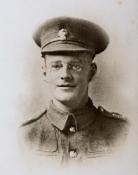
|
The King's School Canterbury |
Roll of Honour |
| Corporal Basset WRIGHT (5981) | |
|
20th (Service) Battalion Royal Fusiliers (City of London Regiment) (3rd Public Schools) Date of birth: 19th April 1890 Date of death: 20th July 1916 Killed in action aged 26 Commemorated on the Thiepval Memorial Panel and Face 8C, 9A and 16A |

|
| He was born at Derby on the 19th of April 1890, the eldest son of James Wright, architect and surveyor, and Elizabeth (nee Walton) of 122 Clarence Gate Gardens, Dorset Square in London, later of 19 Hartington Mansions, Hartington Place, Eastbourne. He was christened at Quarndon in Derbyshire on the 19th of June 1890. He was educated at a school at Godstone in Surrey, and at the King's School Canterbury on a House Scholarship from January 1904 to December 1905, where he was in Holme House. In January 1906 he moved to Marlborough College to complete his education where he was in Summerfield House until July 1909. He went on to Oriel College, Oxford, where he attained a BA in 1912. The school register records that he joined the Australian Infantry on the outbreak of war but there are no records for him in the archives there. He was living in Eastbourne when he enlisted in the Royal Fusiliers in London and he embarked for France on the 14th of November 1915. On the 14th of July British forces had attacked High Wood to the north of the villages of Longueval and Bazentin-le-Petit on the Somme. The attack had failed and it was decided that on the 20th another attempt was to be made with the 20th Battalion Royal Fusiliers being in support of the 5/6th Battalion Scottish Rifles. The British artillery barrage opened fire at 2.55am and, 40 minutes later, the leading units of the Scottish Rifles forced their way into the wood, where they came under heavy machine gun fire from a surviving German machine gun position. As the Fusiliers moved forward German shellfire landed amongst them causing around 20 casualties. The shellfire also caused the battalion to crowd up and eliminate the gap between them and the Rifles. The lower half of the wood was in British hands by dawn but machine guns were taking a heavy toll with the Fusiliers command structure "literally shot to pieces" as the battalion dug in to face the inevitable counterattack. During the early afternoon, reinforcements arrived and this enabled the troops to be rallied and push even further forward and all but the northern edge was later in British hands. At dusk, the Germans lashed the area with shell and machine gun fire and this forced the British to give up the northern half of the Wood which was quickly occupied by the enemy. The two sides dug in and the Fusiliers were relieved at one o?clock the following morning. 397 officers and men, two thirds of the effective strength of the 20th Battalion, had become casualties. High Wood was finally secured on the 15 September. It is estimated that the remains of 8,000 men may still lie in the Wood one of which is Basset Wright whose body was never recovered. His brother, Lieutenant James Turstin Wright RN OKS Royal Naval Air Service, was killed on active service on the 17th of July 1919. |
|
| Holme House |
Back